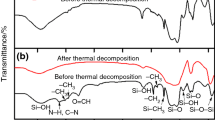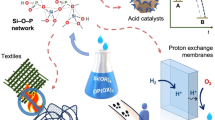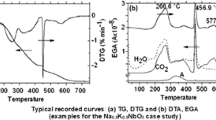Abstract
The hydrolysis-polycondensation of organically modified Si-alkoxides leads to the obtaining of inorganic-organic hybrid materials in which the organic moieties remain as permanent groups bonded to the inorganic network.
The molecular species previously determinated by GC-MS during the gelation process have been significantly different according to the type of the alkoxide used.
In the present work, thermal stability of SiO2-based inorganic-organic hybrid materials starting with TEOS (tetraethoxysilan), MTEOS (triethoxymethylsilan), VTEOS (triethoxyvinylsilan) and MTMOS (trimethoxymethylsilan) was studied.
The molecular structure of the gels obtained determines differences in their thermal behaviour. Gels obtained starting with MTEOS show the highest thermal stability, while gels obtained using VTEOS the lowest, among the substituted alkoxides. A particular behaviour presents the gel obtained with MTMOS that decomposes in four steps. This could be explained by the presence in the gel of some prevalent types of molecular species with different thermal stability.
Similar content being viewed by others
References
C. L. Beaudry and L. C. Klein, ‘Sol-gel processing of silica-poly (vinyl acetate). Nanocomposites’, in: Nanotechnology, Molecularly Designed Materials, ACS Symposium, Series 622, Ed. American Chemical Society, Washington, DC, 1996, p. 382.
M. Zaharescu, A. Jitianu, V. Bādescu and M. Radu, ‘Comparative study of the sol-gel transition mechanism of different substituted Si-alkoxides’, Proc. of the 9th CIMTEC, World Ceramic Congress and Forum on New Materials, Florence, Italy; 14–19 June, 1998, to be published.
V. Bādescu, M. Radu, M. Zaharescu and A. Vasilescu, J. Sol-Gel Sci. Technol., 2 (1994) 43.
M. Zaharescu, V. Bādescu, A. Vasilescu and M. Radu, Rev. Roumain. Chim., 42 (1997) 633.
A. Bertoluzza, C. Fagnano and M. A. Morelli, J. Non-Cryst. Solids, 48 (1982) 117.
Q. Deng, K. A. Mauritz and R. B. Moore, ‘Organic Modification of Surfaces of Silicon Oxide, Nanoparticle Grown in Situ’, in: Hybrid Organic-Inorganic Composites, Ed. J. E. Mark, C. Y-C. Lee and P. A. Bianconi, ACS Symposium Series 585, Ed. American Chemical Society, Washington, DC, 1995, p. 66.
A. Morikawa, Y. Iyoku, M. Kakimoto and Y. Imai, Polymer Journal, 24 (1992) 107.
A. B. Wojcik and L.C. Klein, J. Sol-Gel Sci. Technol., 5 (1995) 77.
A. M. Klonkowski, K. Koehler, T. Widernik and B. Grobelna, J. Mater. Chem., 6 (1996) 579.
M. Popall and X.-M. Du, Electrochim. Acta, 40 (1995) 2305.
Author information
Authors and Affiliations
Rights and permissions
About this article
Cite this article
Zaharescu, M., Jitianu, A., Brãileanu, A. et al. Thermal Stability of SiO2-Based Inorganic-Organic Hybrid Materials. Journal of Thermal Analysis and Calorimetry 56, 191–198 (1999). https://doi.org/10.1023/A:1010132703144
Issue Date:
DOI: https://doi.org/10.1023/A:1010132703144




